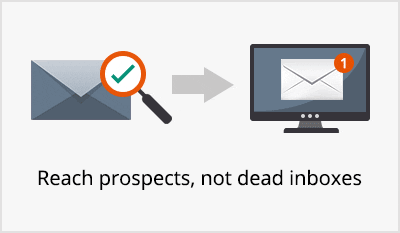With digital literacy being at its peak, customer expectations from eCommerce brands have taken a significant turn in the last few years.
Today, every e-retailer needs to demonstrate their bond with the customer continually. Failing to do so would make the customer forget all about you and your product.
In such a scenario, email marketing is a godsend. With appropriate data from analytics and customer information, it works wonders for firms and business establishments. Email is an extremely important tool in your overall plan of digital marketing for ecommerce website.
It will be fair to say that a good email marketing strategy can be a thin line between the success and failure of an online business.
Let’s understand how you can use email for ecommerce marketing.
1. Segmenting the target audience
Being in the competitive eCommerce industry, if you don’t know your target audience, you’re more likely to make losses in all your campaigns.
It is when you are aware of the customer you are speaking to, will you be able to talk in a manner that they can easily understand.
You need to invest your time and effort in analyzing the data available to understand your audience in the form of interviews, surveys, and other research facts.
The more time you spend on it, the better gleaning insights you will have about your customers and the market in question.
EmailMonks shared a guide (image below) in which they explain how to segment the audience, target them differently for multiple campaigns, and position them to send the right message each time.
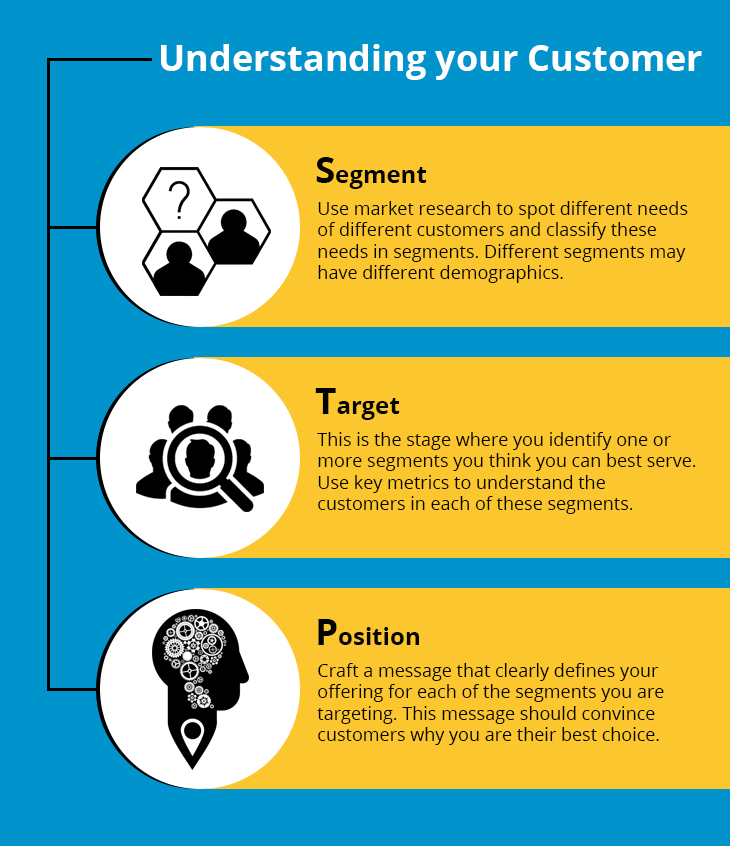
The key to understanding your customers is to identify different customer needs. Various parameters, like behavior, occupation, interests, and demographics, are what decides the customer needs. For different businesses, the parameters vary.
Once you do that, the next major step is to identify the segment that you want to target for a particular marketing campaign.
At this point, try to study the customer life cycle, their behavior and key metrics of this target group. This helps you position the marketing campaign to work in your chosen segment.
When you have perfectly segmented customer groups, your email marketing campaigns help you gain higher traction than before.
2. Validating the email list per campaign
What if you know your audience well, but don’t know whether you have their right email addresses or not?
Sending to the invalid email addresses will cost you double with minimum to no ROI.
That’s why, when you opt for email marketing, it is essential to know the accuracy of the email addresses of your targeted group before sending them.
In the modern age of cut-throat competition, email verifications help you to save on precious time and win your customers too.
Read on to know the benefits of email validation as per the requirements of your eCommerce marketing campaigns:
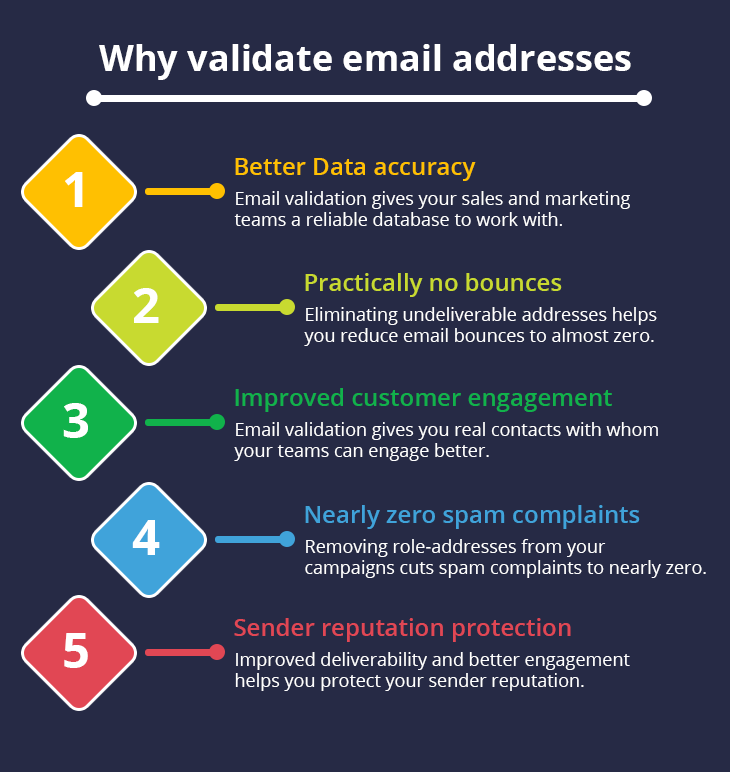
A. Speaks of data accuracy
The easiest way to check whether the data that you have in hand is accurate or not is to validate the mailing list. Having one or two incorrect addresses is okay. But, if you find yourself with a large percentage of email ids being undeliverable, you should take that as a cue and start working on improving things.
B. Brings down bounced emails and saves money
With email validation, you know beforehand which email is undeliverable. That way, you can have a clean list that has only those email ids that are correct. This will shrink your email list and save you the extra money in storing the unnecessary email ids and sending emails to them.
C. Improves customer engagement and ROI
By removing the non-existent email ids from the list, you will have a better opportunity to engage with the real recipient. The emails will now be more relevant, and customers receiving them will have a higher chance of purchasing your product or service.
D. Lowers spam complaints
If you are sending out marketing campaigns (like support@, sales@ or marketing@), you should worry about the spam complaints that come in. That is because when customers send a spam complaint to that, multiple people will get to know of it. To avoid that, opt for email verification tools that remove role address from your mailing list.
E. Protects sender reputation
Factors like how often your recipients flag your email as spam, your ISPs and ESPs aid the calculation of your sender reputation. By opting for validating your email list, you will ensure that you do not send out emails to people who would reject it. That way, you protect your sender reputation.
These days, there are several email verification tools. These tools help you ascertain whether a given email address is genuine or not. After all, you cannot compromise on your eCommerce brand’s reputation.
3. Executing a well-planned email series
It’s not always about conversions for eCommerce, but it is the ultimate goal of any email marketing campaign. But, is it that simple? Only sending promotional emails or discounts in your emails can get you conversions? Not, it’s not like that.
Sending one or two emails randomly has never helped an eCommerce brand to grab customers attention. 31.6% of people said they flag an email as spam when they find irrelevant content in the emails as per a survey by TechnologyAdvice (shown below).
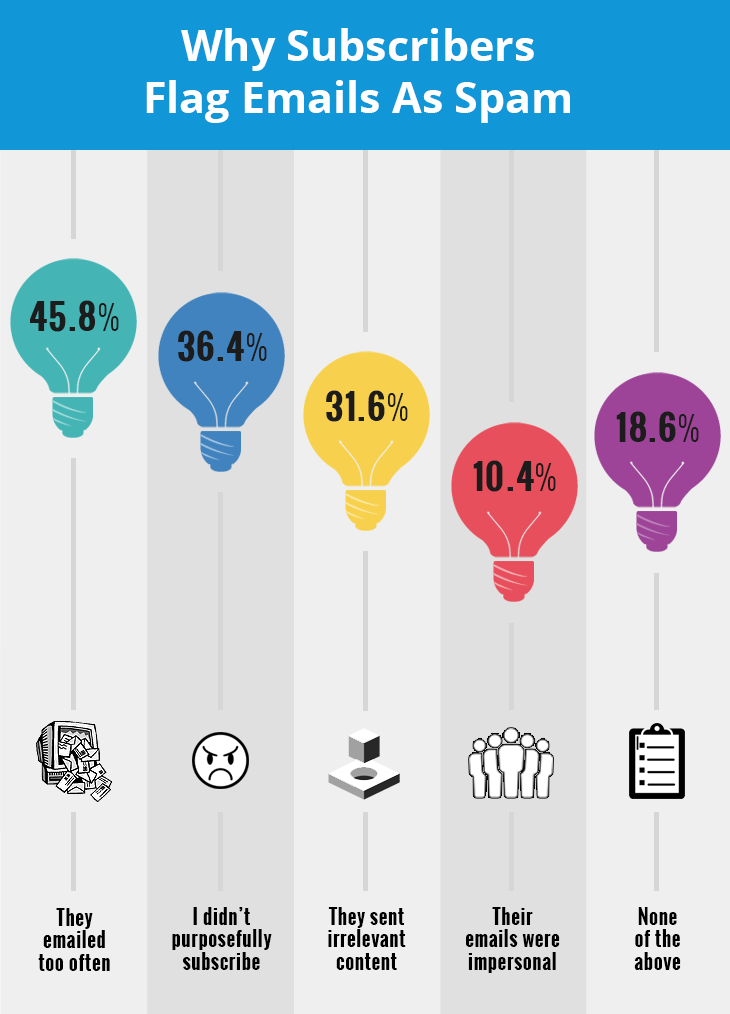
To avoid such spam flags, you need to plan an email series targeting your segmented groups for each of the customer stages.
What types of email series can you plan apart from usual promotional ones? Moropost discusses nine types of email campaigns. But, six among those nine campaigns every eCommerce brand must plan-
A. Welcome Email Series
The moment you have a new subscriber, it is the responsibility of your brand to build a good rapport with them. One of the easiest ways of doing that would be by giving a brief introduction about your product or service and thanking the customer for being a part of your business family. You may also take it a step further and gift them a coupon or some other gift. Make sure that you do not take too long to contact a new subscriber as that will take the excitement on the part of the customer off the plate.
B. Seasonal Campaigns
Focus your email marketing campaigns to create a build-up before any major festival. Let your customers know about the special offers you have lined up for Halloween, Black Friday, Valentine’s Day, Christmas or Diwali. With this, you will ensure that they make their purchases from you and not from your competitors.
C. Triggered emails
Ever since its inception, triggered emails are getting too much attention. And, the results that it generates is the reason behind the same.
Triggered emails get 70.5% of more open rates compared to the other emails, as per WebFX (shown in the image below).
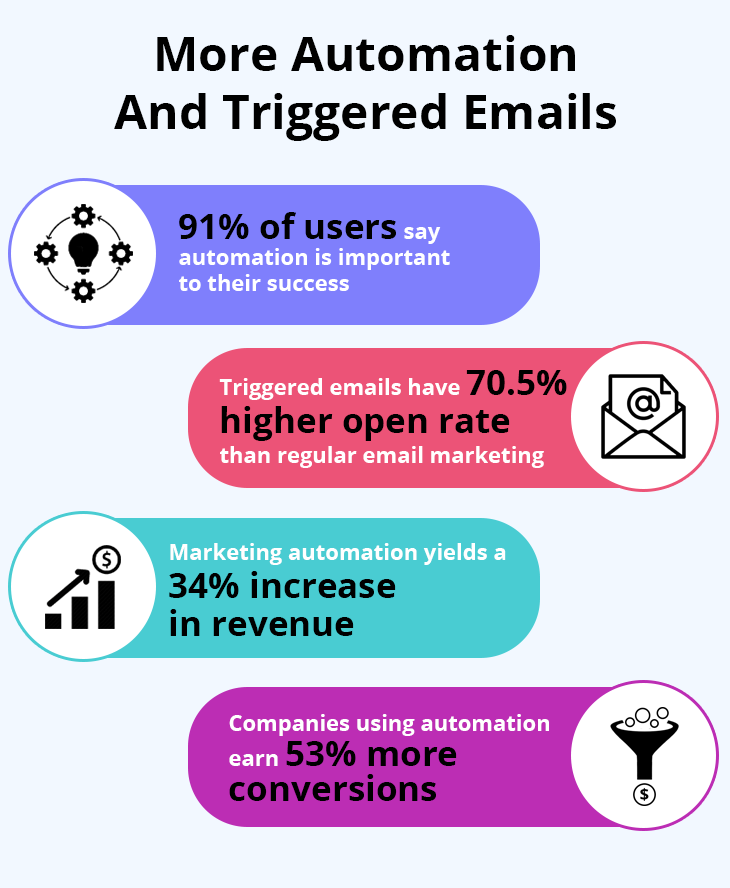
Some email marketing tools provide triggered emails which you can use for your multiple campaigns.
D. Post-purchase drip
The difference of a post-purchase drip from that of other marketing techniques is the fact that it does not necessarily promote an item.
All you do here is to catch up with a customer after he has purchased an item from you. This need not be an email asking for feedback. You can send out blogs, video tutorials, or graphics on how to care for the product or on other users of the product.
Doing things like this helps in building brand loyalty. That way, the next time the customer has to purchase something, he will directly rush to you.
E. Abandoned cart
Almost 3/4 th of your customers leave your eCommerce store without making a purchase, as reported by Barilliance.
Hence, tackling cart abandon ratio becomes crucial, and a dedicated email campaign for the same needs to be planned.
As an abandoned cart campaign is an automated campaign, it will not take much of an effort on your part.
When a customer puts an item on their virtual cart but does not make the purchase right away, you can send a reminder email to them. Doing this helps in customer engagement and promotes your brand.
F. Re-engagement campaign
This campaign is effective in getting back inactive customers. Start by identifying customers who haven’t opened any of your emails in the last 4 to 6 months. Then, instead of removing them from your list (as that will affect your ISP reputation) come up with business models to engage them. If needed, you may even need to roll out some discount schemes to attract them back.
Campaigns may fail if sent without testing
Now, irrespective of the type of marketing campaign you go for, it’s vital that you run the A/B tests before you try out anything new.
Neil Patel guides on how to effectively perform A/B testing for your email marketing campaigns.
- Start by identifying what is it that you would want to test.
- Although it might be tempting to test multiple things at a go, doing it one parameter at a time will yield the best results.
- Once you have decided on a parameter, try to consider the most significant sample that you can afford.
The key to an efficient A/B test is to have the data be as random as possible.
4. Checking for mistakes before scheduling/sending
To win this eCommerce game, you’ve segmented your customers, validated their email addresses, and have a perfectly planned email series.
But there is one problem. What if you haven’t realized that your email content might contain errors?
Email marketing is a world where there is no room for any mistakes. Any mistake on your part here will cost your eCommerce brand (or potentially even more) a client. That is why you must go for thorough testing before you schedule or send out emails.
Here are the top 3 email marketing mistakes you’ll want to stay clear of:
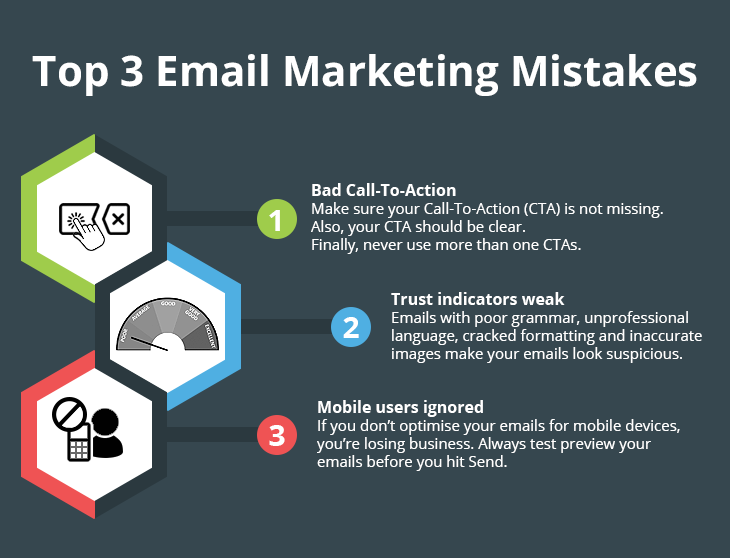
A. Your Call-To-Action is missing or confusing
First of all, make sure that you have a Call-To-Action (CTA) in your email. It’s important that you tell your subscribers what action you want them to take.
Secondly, always have one and only one CTA in your email. If your email has more than one CTAs, you’ll confuse your subscriber. And that means your subscribers will likely not take any action.
Finally, make your CTA clear. For instance, a CTA button that says, “Download the eBoook” clearly tells the subscriber what will happen when they click the button. If you simply write “Click here”, you leave the subscriber wondering about the outcome of clicking the button.
B. Your email doesn’t evoke trust
Remember when you’re trying to promote or sell something, you’re asking someone to pay you money in exchange of whatever you’re trying to sell. Unless your email subscribers can trust you, there’s no way they are going to give you any money.
Poor spelling or grammar, unprofessional language and cracked formatting are three major factors that can make an email look immediately suspicious. To avoid this, double-check everything before you hit Send.
Finally, be careful with images. If you are using images, avoid stock images. A real image of the product or an event hugely improves credibility.
C. You didn’t think of mobile users
An estimated 54% of Cyber Monday visitors to ecommerce sites came from mobile devices, and 30% made a purchase through mobile devices. (Source).
If you don’t optimise your emails for mobile devices, you’re losing lots of potential traffic and revenue.
Fortunately, there are a number of email testing tools available. Before you actually send your marketing emails, you can use these tools to check how your emails will appear on different devices or email clients. Pay particular attention to image size, fonts and margins.
5. Measuring the results
How measuring the results help in winning customers? Until and unless you know how your email marketing strategy and campaigns work, you cannot improve them.
For any eCommerce business, email marketing is an investment, and companies seek to get maximum profit out of this. Measuring the results become essential here.
Usually, how much traffic and leads your email marketing campaigns have generated can be found using Google Analytics.
But, that does not help you figure out the Return on Investment (ROI) of your campaigns.
CampainMonitor simplified the process of measuring the email marketing ROI and here is how it is-
The basic formula- gained – spent/spent = ROI (expressed as a percentage)
Step 1: Calculate how much you’ve spent
Step 2: Calculate how much you’ve gained (from Google Analytics)
Step 3: Calculate your cost per lead
Step 4: Calculate ROI (Gain – spent)/spent = ROI)
An example from CampaignMonitor:
Your email marketing spend in a year = $10,080.
If the cost of your lead is $100 and your email campaign brings 300 leads/year, your total revenue from email becomes $30,000.
With all this data, you can then calculate your ROI as:
($30,000 – $10,080)/$10,080 = 197.6%
That’s how you calculate the ROI on your email marketing campaigns and figure out what changes you need to make to boost this ROI every year.
Incorporate email marketing to build a solid customer base
At the core of a good eCommerce email campaign lies a good strategy. The only way to make an impact on today’s dynamic customer base is to have a well researched and structured email campaign.
Get ready with goals, tools, and resources to provide an unforgettable customer experience to your online buyers with a data-driven email marketing campaign.
It’s worth it!

